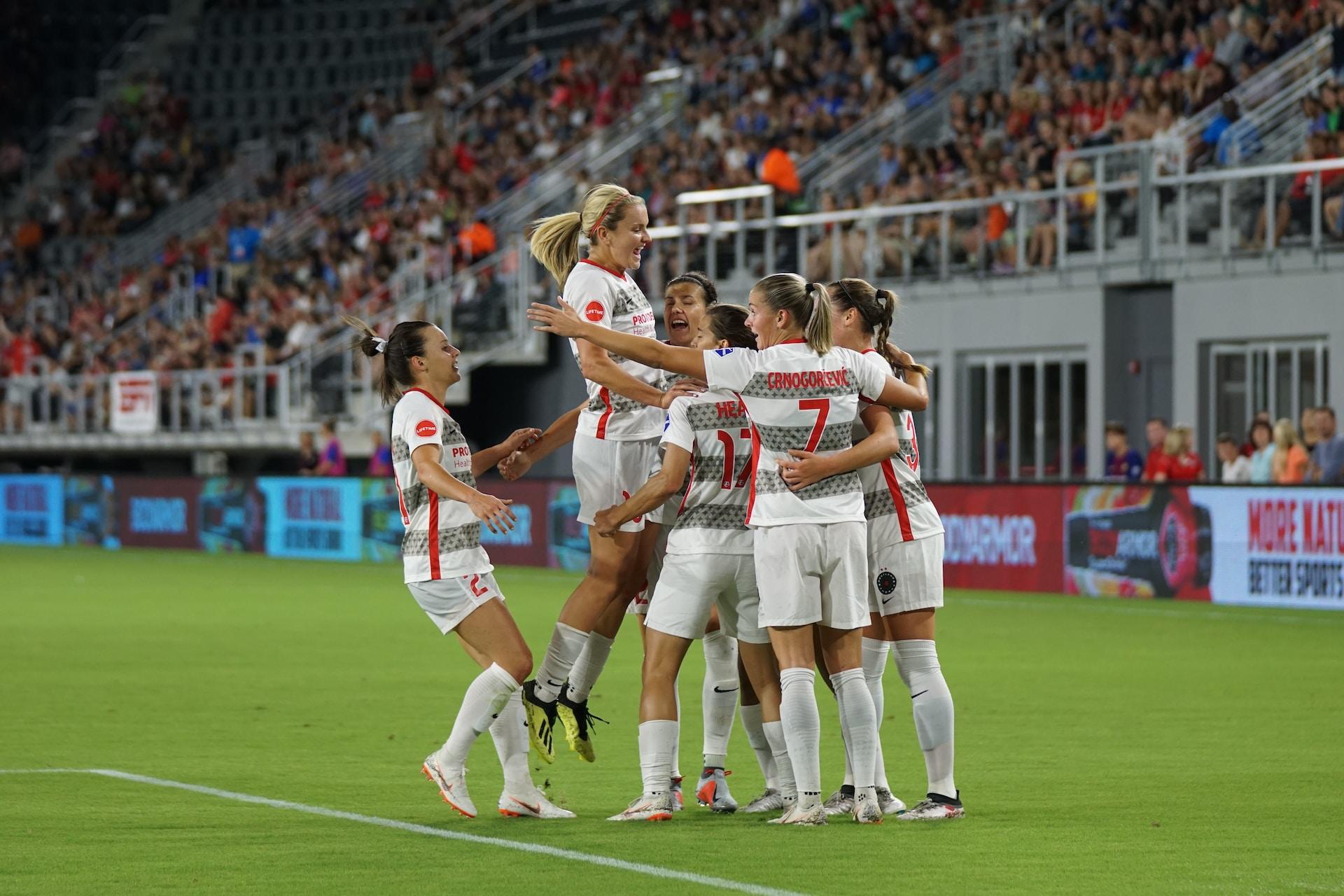The Women's World Cup has only been going since 1991, but the success of the women's game in recent tournaments is astounding as not too long ago, women could really only play soccer for recreation and there was no professional version of the sport for them.
If you've also been inspired by the Matildas in their World Cup performance and have a new or renewed interest in soccer, here's a look at the past, present, and future of the women's game in Australia.

A Brief History of Women's Soccer
The history of the men's game is often spoken about and promoted and highlighted by FIFA during their tournaments, but here's a quick refresher if you aren't familiar with the origins of soccer (or football).

Humans have played many different ball games and sports that involve kicking a ball and while the earliest and oldest examples of this have been found in China, modern association football was invented and codified in the UK in the mid-19th century. The Football Association (FA) in England was founded in 1863 and still exists today.
In the early days of football, there were men's and women's teams and in both England and Australia, the sport was very popular for both.
During the First World War, many of the British players in Australia returned to Europe to fight and the men's game effectively stagnated. However, during this time, the women's game continued.
After the war, men's football returned with those that survived, but the FA's opinion on women playing football changed. While the FA in England didn't technically ban women's soccer, it did essentially make it impossible for women to play by telling clubs not to allow them to play on their pitches.
While this "ban" didn't technically apply to Australia, the sentiment that women shouldn't play soccer was shared by many in the country and women were discouraged from playing soccer in the same way as they were elsewhere around the world.
Many said that soccer was unladylike and some doctors even went as far as to say that it posed certain health risks to women (but not to men).
This ban effectively lasted 50 years and wasn't officially lifted by the FA until 1971. This doesn't mean that women didn't play soccer, but it did mean that they weren't being given the same opportunities, support, and professional structure as men. During this time, women's soccer was a niche and informal affair played by very small numbers of women around the world.
Changing Moods and the Women's World Cup
The men's World Cup was started in 1930, less than a decade after the women's ban and has been played every four years (excluding during World War II) ever since.

Naturally, during the years of the ban, there wasn't any formal women's soccer let alone international tournaments.
With the changing attitudes and the lifting of the ban, soccer became a sport that women all over the world could play, including in Australia, though the sport was half a century behind the men's game because of the ban.
Men's soccer was already established and a global phenomenon whereas women's teams were desperately trying to catch up without the same recognition, funding, or coverage.
It was fortunate in Australia that shortly after the women's ban was lifted, the men's team qualified for the World Cup in 1974, helping to somewhat elevate the profile and status of soccer in the country that easily considers it at least its 4th favourite team sport after rugby, cricket, and the native AFL, of course.
Women's soccer already struggled because of the ban, but in a country where it's not even the most popular sport, it was even harder for girls to play. Girls wouldn't get the same coaching and support as boys and many kids in school would never take up soccer because they'd have believed the sport wasn't for them.
World Cup qualification would have certainly helped rather than hindered the cause even though the men's team wouldn't qualify for another World Cup until 2006. Since then, however, they have qualified for every tournament.
At the time of the men's team's first qualification, however, there still wasn't a national league for women's soccer in Australia, but founding the Australian Women's Soccer Association was a step in the right direction.
In 1991, right in the middle of the men's team's qualification lull, the first ever Women's World Cup was held in China, over 60 years after the first men's tournament and, unfortunately, Australia's women's team (nicknamed the Matildas) failed to qualify.
In every subsequent tournament, however, the Matildas have qualified. Though early tournaments resulted in group-stage eliminations, they did enjoy a spell of reaching the knockout stages of the tournaments and an all-time best result of reaching the semifinals in the tournament co-hosted between Australia and New Zealand.
Not only is the women's game on an upward trajectory, the Australian women's team is doing the same and their success on the pitch will definitely bring more kids into the sport and increase the overall quality of coaching and training for both young girls and boys.

How Much Do Female Soccer Players Get Paid?
While popular opinion of women's soccer is shifting and the game is becoming increasingly popular, men's soccer's 50-year head-start definitely shows and the money in the women's game is still far behind that of the men's game. The women's game is often treated as a subclassification of soccer with men's soccer often considered the default version of the game, but the gap is closing.

With fewer spectators, fans, participants, and sponsors, there's far less money sloshing around and the salaries for female soccer players and pretty much everybody involved in the women's game is paid less than their counterparts in the men's game.
Players and coaches in the women's game will be paid less than players and coaches in the men's game because clubs earn less money. The same is true across different sports and the more money there is in a particular sport, the more players will likely earn.
For example, the world's richest women's soccer player Marta has a net worth of around 13 million USD. The world's richest men's soccer player is technically Faiq Bolkiah of Thailand, but since he also happens to be the Prince of Brunei, we probably shouldn't count him because his riches aren't from soccer.
Lionel Messi is worth an estimated 600 million USD and Cristiano Ronaldo 500 million USD, but these figures are from last year and likely much higher following their high-profile moves to Inter Miami in the US and Al-Nassr FC in Saudi Arabia.
Marta is also an outlier as she's worth nearly double that of the next richest female soccer player Amandine Henry and there's a drastic drop-off in terms of salaries outside of the handful of the very best female players.
Where Next for Women's Soccer?
This year's World Cup has doubled the viewing figures of the previous Women's World Cup that was held in France.
On its own, this would be impressive, but it should be considered even more impressive given the fact that this tournament co-hosted between Australia and New Zealand is in drastically different time zones to the regions where soccer is most popular: Europe, Central and South America, and Africa.
This is also boosted by the fact that soccer isn't even the most popular sport in Australia, but the support and passion behind the tournament from Australians and New Zealanders have been incredible and something that future host nations would do well to copy.
The total attendance for matches in the 2023 Women's World Cup is at an estimated 1.85 million, putting it well ahead of 2015's record attendance of 1.35 million fans in Canada.
At the moment, the growth in popularity and quality of women's soccer is incredible and as long as the support for it continues both domestically and globally, there's no reason that subsequent women's tournaments won't be more popular than this one.
How Can Girls Get into Soccer?
With the ever-increasing popularity of the women's game and World Cup fever naturally following both hosting the World Cup and achieving the country's best-ever success, it's hardly surprising that there'll be an increase in interest.

For girls looking to get started with soccer, there are many options and there'll likely be even more in the future if demand continues to increase.
Finding Female Soccer Clubs Near Me
In most major cities across Australia, there are many soccer coaching academies and local clubs.
You can contact these clubs to ask about their teams and coaching for girls, but you can also use the incredibly useful “Football Finder” on the Play Football Australia website.
Learning to Play Soccer with a Private Coach
Additionally, girls can learn to play soccer with a private coach. While soccer is definitely a team game and requires regular practice through matches and team training, some certain skills and techniques are much more effectively taught through private coaching.
Private coaching is particularly useful for building self-confidence, too, and is a great way for shyer girls to feel comfortable playing soccer before joining teams or academies, especially those who may have to play in mixed teams at the younger levels.
If you'd like to find a private soccer coach for your daughter, you can always search for soccer and your town on the Superprof website where you'll find tutors and coaches from all over the world.
You can browse each coach's profile, see how much they charge per hour, and even see what their other customers had to say about them and their coaching.
It's important to choose the right coach for your daughter so consider checking out the coaches that offer the first session for free and trying a few of them out before deciding which one is best.
Find your perfect coach for soccer classes near me on Superprof!

















